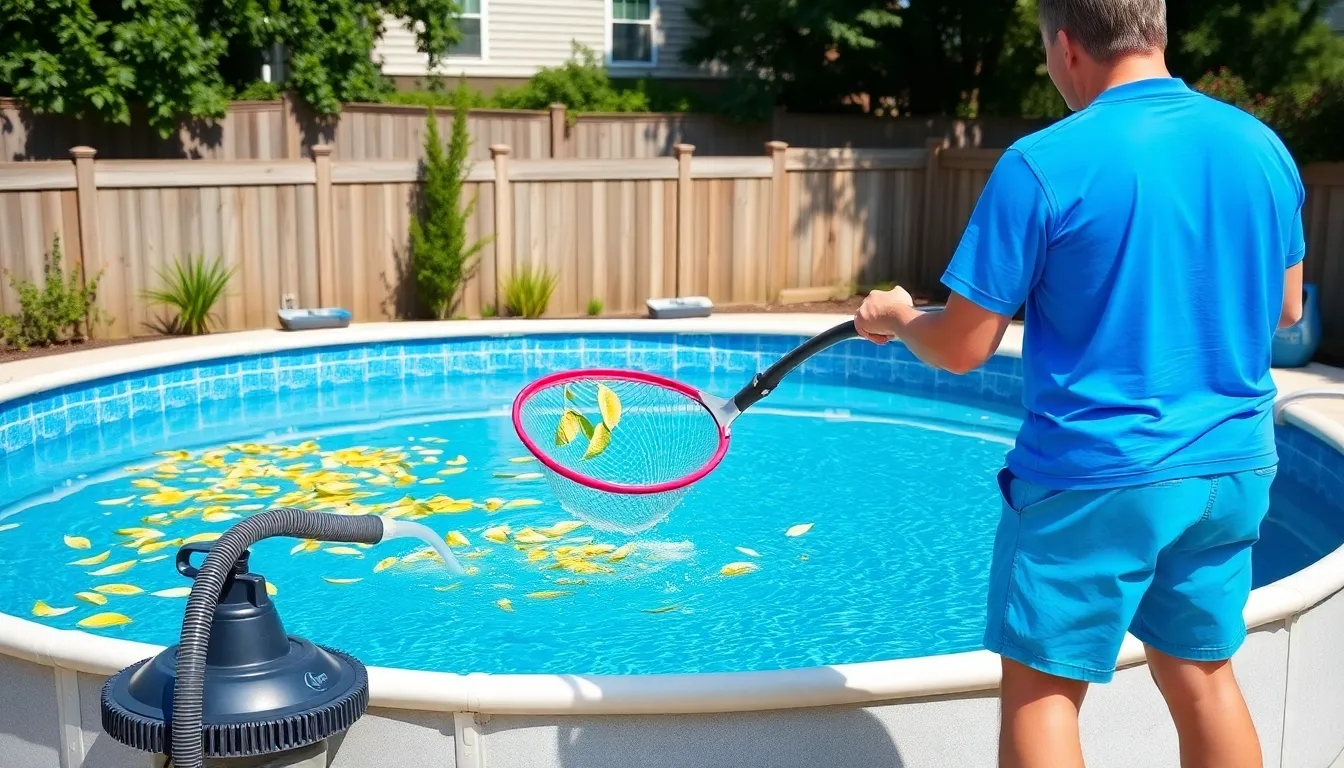Table of Contents
ToggleSummer’s just around the corner, and that means it’s time to dive into the joys of above ground pool ownership. But before you cannonball into bliss, there’s a little thing called maintenance that can make or break your backyard paradise. Forgetting about pool care is like inviting a family of raccoons to your barbecue—it’s messy and no one wants to deal with the aftermath.
Understanding Above Ground Pool Care
Effective above ground pool care ensures a safe and enjoyable swimming experience. Taking charge of maintenance can prevent complications that arise from neglect.
Importance of Proper Maintenance
Proper maintenance plays a crucial role in pool health. Regularly checking pH levels can prevent cloudy water and skin irritations. Additionally, consistent cleaning keeps debris at bay, reducing the risk of algae growth. Laying out a maintenance schedule helps owners stay organized, covering tasks like filtration and chemical balancing weekly. Ensuring equipment like pumps and filters operates efficiently promotes water circulation and clarity. Following these practices results in a more inviting swimming environment.
Common Challenges in Pool Care
Many challenges arise in above ground pool care. Debris accumulation, whether from leaves or dirt, often leads to unwanted bacteria growth. Maintaining the right chemical balance can be tricky, especially with fluctuating weather conditions. Other common issues include equipment malfunctions and leaks, which can disrupt pool enjoyment. Owners should also be aware of water temperature fluctuations that may affect comfort. Addressing these challenges promptly fosters a healthier swimming area and enhances overall satisfaction.
Essential Tools for Pool Care

Having the right tools ensures smooth maintenance and a clean swimming environment. Owners should invest in essential equipment to uphold pool quality and safety.
Cleaning Equipment
Cleaning equipment is vital for keeping the pool pristine. A skimmer net efficiently removes debris such as leaves and insects from the water surface. A pool vacuum helps eliminate dirt settled at the bottom, ensuring clarity. Brushes, specifically designed for pool surfaces, tackle algae and grime effectively. Furthermore, a leaf rake can assist in larger debris collection, making cleaning easier. Regular use of these tools maintains both the aesthetic appeal and hygiene of the pool.
Testing Kits
Testing kits play a crucial role in maintaining water chemistry. A quality test kit typically includes pH strips and chlorine testers for accurate assessments. Regular testing aids in identifying chemical imbalances swiftly. Additionally, some advanced kits feature digital readers that provide precise readings, simplifying the process. Keeping track of chemical levels ensures a safe swimming environment and prevents irritation or health issues. Owners should perform testing at least once a week to uphold water quality.
Routine Maintenance Tasks
Routine maintenance tasks ensure an above ground pool remains clean and safe. Regular attention to these areas enhances the swimming experience.
Skimming and Vacuuming
Skimming the pool’s surface daily removes leaves, insects, and other debris. This simple task prevents buildup that can clog filters. Vacuuming the pool should occur weekly to eliminate dirt and algae from the bottom. A manual or automatic vacuum can effectively remove unwanted particles. Combining skimming and vacuuming promotes water clarity and hygiene. Maintaining a clean pool surface also deters the growth of harmful bacteria. Owners often find that these tasks become quicker over time, leading to a more pleasant swimming environment.
Water Chemical Balancing
Balancing water chemistry is essential for pool health. Test the water at least once a week to identify pH levels and chlorine content. Optimum pH should range from 7.2 to 7.8, ensuring a safe swimming experience. Chlorine levels should stay between 1 and 3 parts per million. Adjusting chemicals promptly prevents issues like skin irritation or cloudy water. Regular monitoring also helps protect equipment from corrosion or damage. Using a reliable testing kit simplifies this process, allowing pool owners to maintain safe conditions easily. Prioritizing these chemical checks contributes significantly to overall pool enjoyment.
Seasonal Pool Care Tips
Seasonal pool care focuses on proper opening and closing techniques for above ground pools. These practices ensure optimal health and enjoyment throughout the swimming season.
Opening Your Above Ground Pool
To begin the season, conduct a thorough inspection of the pool and its components. Remove the winter cover, and allow the pool to breathe. Next, check for debris and clean the area surrounding the pool. Fill the pool with water to the appropriate level, which typically requires adding several inches of water to replace any lost during winter months. After filling, reconnect the filter and pump, ensuring they function properly. Balance the water chemicals by testing for pH and chlorine levels, adjusting them to safe ranges. Finally, run the pump for at least 24 hours to circulate chemicals and eliminate stagnant water.
Closing Your Above Ground Pool
When the swimming season ends, begin closing procedures to protect the pool. Start by cleaning the pool, scrubbing surfaces, and vacuuming the bottom. Lower the water level below the skimmer to prevent freezing damage. Disconnect and drain all equipment, including the pump and filter, to avoid potential freeze issues. Cover the pool with a durable winter cover to keep debris out during the off-season. Utilize winterizing chemicals to stabilize water chemistry. Monitor the cover throughout the winter, removing snow and debris to maintain its integrity and ensure an easier reopening.
Troubleshooting Common Issues
Maintaining an above ground pool can present challenges, but knowing how to troubleshoot common issues simplifies care.
Algae Growth Solutions
Algae growth often indicates imbalanced water chemistry or inadequate circulation. To address it, first check chlorine levels; they should remain between 1-3 parts per million. If levels drop, adding chlorine shocks the pool effectively. Regular brushing and vacuuming remove algae from walls and floors, promoting cleanliness. Furthermore, using algaecides can target persistent growth. Maintaining proper filtration cycles, about 8-12 hours daily, enhances water circulation to combat algae. In addition, keeping pH levels between 7.4-7.6 fosters a healthier environment that discourages algae proliferation.
Equipment Problems
Equipment malfunctions can disrupt regular pool care. Firstly, ensure the pump operates effectively; a functional pump should run for a minimum of 8 hours daily. If it fails, check the power supply, filters, and impeller; clogs often lead to performance issues. It’s crucial to inspect hoses and connections for leaks that compromise efficiency. Additionally, maintaining clean filters, replacing them every 1-2 months, ensures optimal operation. If the heater doesn’t produce warm water, examining the thermostat settings should be a priority. Addressing these common equipment concerns promotes a smoother and safer swimming experience.
Maintaining an above ground pool is vital for ensuring a safe and enjoyable swimming experience. By staying on top of regular cleaning and chemical balancing, owners can prevent common issues that detract from pool enjoyment. Using the right tools and following a maintenance schedule simplifies the process and keeps the water clear and inviting.
Seasonal care practices also play a significant role in protecting the pool during off-peak times. By addressing potential challenges promptly, pool owners can enhance their overall satisfaction and make the most of their investment. With a little effort and attention, an above ground pool can provide endless summer fun for family and friends.




